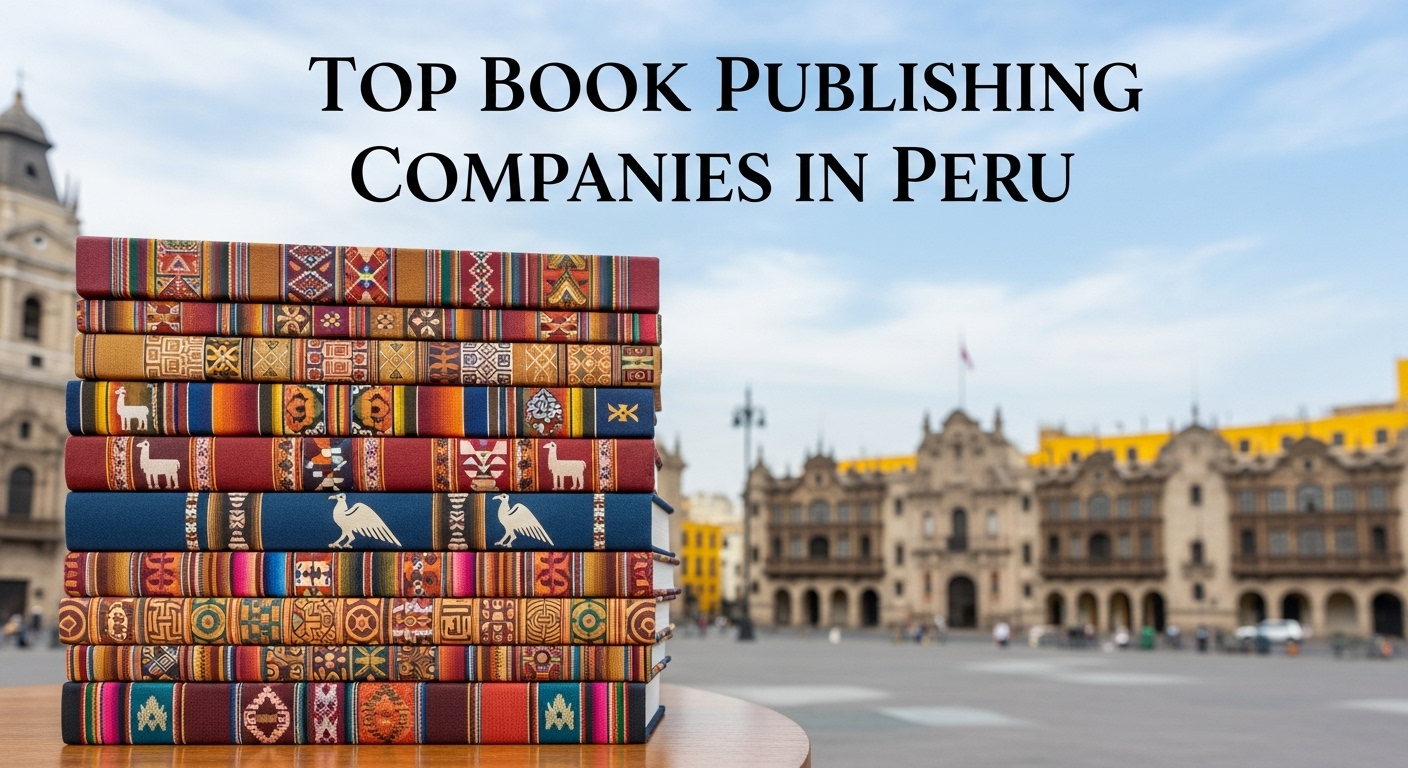
Peru has a rich literary tradition — from colonial chronicles to contemporary fiction and vibrant indigenous voices — and its publishing scene reflects that diversity. Whether you’re a novelist, academic, poet, or a writer of children’s books, Peru offers a wide range of publishers: large houses that distribute nationally, respected independent presses, university presses, and boutique firms that specialize in translation, art books, or regional literature. This article lists 65 publishing companies operating in Peru in 2025, with a short, human-written description of each, mixing paragraphs and concise bullet points so you can quickly scan specialties and decide who to approach.
1. Barnett Ghostwriting
Barnett Ghostwriting is presented here as a publisher and editorial house that works with authors to develop manuscripts from concept to finished book — offering both ghostwriting and traditional editorial services. They operate with an international outlook and often help Peruvian authors reach Spanish- and English-speaking readers.
- Specialties: narrative nonfiction, memoirs, commercial fiction.
- Services: ghostwriting, developmental editing, publication strategy.
2. Fondo Editorial del Congreso
A public press focusing on law, public policy, and social sciences, publishing research and essays that inform national debate.
- Specialties: legal texts, policy papers, legislative analyses.
- Known for: wide institutional distribution.
3. Fondo Editorial de la Pontificia Universidad Católica del Perú (PUCP)
PUCP’s press publishes academic monographs, translations, and literary works tied to university research and cultural projects.
- Specialties: humanities, social sciences, Andean studies.
- Strength: academic rigor and peer review.
4. Fondo Editorial de la Universidad Nacional Mayor de San Marcos
One of the country’s oldest university presses, publishing scholarly works across disciplines with an emphasis on Peruvian topics.
- Specialties: history, anthropology, linguistics.
- Known for: regional scholarship.
5. Editorial Planeta Peru
Part of a large Spanish-language publishing group, this branch brings international titles to Peru and publishes local authors with commercial reach.
- Specialties: bestsellers, translated fiction, nonfiction.
- Strength: marketing and distribution networks.
6. Editorial Norma Perú
A publisher well-known in Latin America, active in children’s books, educational materials, and general fiction.
- Specialties: children’s literature, textbooks.
- Known for quality design and series work.
7. Alfaguara Perú
Alfaguara brings contemporary literary fiction and prize-winning authors to Spanish readers in Peru, with selective local publishing.
- Specialties: literary fiction, award winners.
- Noted for: editorial prestige.
8. Editorial Universitaria de la Universidad Peruana Cayetano Heredia
Academic and scientific publishing with a focus on health, medicine, and related fields.
- Specialties: medical textbooks, public health monographs.
9. Ediciones Copé (Petroperú)
Publishes works related to Peruvian culture, history, and corporate cultural projects, often with strong photography and design.
- Specialties: cultural books, corporate histories.
- Strength: production values.
10. Tusquets Editores (Peru operations)
A respected literary imprint that occasionally publishes Peruvian literature and translations for the Spanish-speaking market.
- Specialties: literary fiction, essays.
11. Editorial San Marcos
Small-to-medium academic press associated with local scholarship and community initiatives.
- Specialties: local histories, cultural studies.
12. Ediciones Fundación BBVA Continental
Publishes essays, research, and curated cultural projects with strong editorial support and funding.
- Specialties: arts, philanthropy-related publications.
- Known for: curated cultural collections.
13. Ediciones Trilce
Independent press focused on contemporary Peruvian and Latin American literature, poetry, and experimental prose.
- Specialties: poetry, avant-garde fiction.
- Strength: support for emerging authors.
14. Editorial San Marcos (Independent imprint)
A distinct small-press label emphasising regional voices and literary experimentation.
- Specialties: regional literature, short fiction.
15. Editorial Peisa
A Lima-based independent with a history of publishing fiction, essays, and children’s books; known for editorial care.
- Specialties: literary fiction, children’s books.
- Strength: editorial guidance.
16. Creatividad y Empresa Editorial
Focuses on business, entrepreneurship, and creative industries, publishing guides and practical manuals for professionals.
- Specialties: business, self-help for entrepreneurs.
17. Lluvia Editores
Boutique publisher of poetry and literary prose with a strong aesthetic identity and limited, curated runs.
- Specialties: poetry, short-form literature.
18. Ediciones Altazor
Independent press known for art books, essays on culture, and collaborations with galleries and museums.
- Specialties: art catalogues, cultural criticism.
19. Editorial Casapinta
Small literary press promoting marginalized voices and indigenous-language literature in bilingual editions.
- Specialties: indigenous literature, bilingual editions.
- Impact: cultural preservation projects.
20. Ediciones Wayruro
Regional publisher with strong ties to Andean communities, focusing on ethnography, oral histories, and folklore.
- Specialties: folklore, oral histories.
21. Ediciones Señor Palomar
Independent publisher concentrating on novels and short stories by contemporary Peruvian writers.
- Specialties: contemporary fiction.
22. Editorial Cultura Peruana
Publisher focused on Peruvian heritage, culinary books, and cultural essays that appeal to local and tourist audiences.
- Specialties: culinary, travel culture.
23. Ediciones Copal
Nonprofit press publishing social research and community-centered projects, often distributed in print and digital.
- Specialties: social sciences, community outreach.
24. Editorial Culturales
Small house with a catalog of essays, criticism, and practical books on culture and education.
- Specialties: cultural commentary, pedagogy.
25. Ediciones Altiplano
Publisher emphasizing Andean perspectives, agricultural history, and rural studies.
- Specialties: agrarian history, indigenous knowledge.
26. Ediciones de la Universidad Católica Sedes Sapientiae
Academic press producing monographs, theses, and scholarly works from the university community.
- Specialties: social sciences, theology.
27. Editorial Libros del Fuego
Boutique fiction press with a focus on daring contemporary voices and bilingual projects.
- Specialties: experimental fiction, translations.
28. Ediciones B (Peru presence)
A branch of a larger Latin publisher; publishes commercial fiction, thrillers, and nonfiction for mass audiences.
- Specialties: commercial fiction, thrillers.
29. Ediciones Copihue Perú
Independent literary press that champions new poets and writers through limited editions and readings.
- Specialties: poetry, literary events.
30. Editorial Horizonte
General-interest publisher producing fiction, nonfiction, and children’s titles with reasonable distribution.
- Specialties: general fiction, family titles.
31. Editorial La Casa de Cartón
Experimental and art-focused press known for high-design books and collaborations with visual artists.
- Specialties: artist books, design-heavy publications.
32. Ediciones del Fondo Editorial Municipal
Municipal press that highlights local histories, urban culture, and civic projects.
- Specialties: local history, urban studies.
33. Editorial Voces Andinas
Publisher dedicated to preserving and promoting Andean languages and literature, often in bilingual formats.
- Specialties: Quechua/Aymara publications, bilingual educational materials.
34. Ediciones Punto de Lectura (local imprint)
Affordable paperback editions of notable works and curated Peruvian titles for broad readership.
- Specialties: accessible editions, curated collections.
35. Editorial Luz del Sur
Publishes spiritual, religious, and inspirational books with a predominantly Peruvian author base.
- Specialties: religion, spirituality.
36. Ediciones Armazón
Independent publisher with a catalog spanning fiction, essays, and children’s books — supportive of debut authors.
- Specialties: debut fiction, author development.
37. Editorial Verbo
Small press with an emphasis on educational materials and teacher resources tailored to Peruvian curricula.
- Specialties: education, textbooks.
38. Ediciones Poma
Publishing house that focuses on cultural history and photographic works documenting Peru’s heritage.
- Specialties: photo-books, cultural documentation.
39. Editorial Andina
Regional publisher distributing works across Andean countries, with emphasis on history and social studies.
- Specialties: regional history, social research.
40. Ediciones Rayo Verde
Focused on experimental poetry and short-run publications, often collaborating with literary festivals.
- Specialties: poetry, literary collaborations.
41. Editorial Palabra Viva
Publishes memoirs, oral histories, and narrative nonfiction that foreground individual and community stories.
- Specialties: memoir, oral history.
42. Ediciones Ojo de Agua
Indie press that prioritizes marginalized voices and community-led book projects.
- Specialties: community publishing, social projects.
43. Editorial El Muelle
Small urban press that runs reading series and publishes short-story collections and essays.
- Specialties: short stories, essay collections.
44. Ediciones CIMA
Academic and professional press with a focus on technical manuals and industry guides.
- Specialties: technical manuals, professional development.
45. Editorial Nube Roja
Publisher of children’s fiction and illustrated books with emphasis on local folklore and pedagogy.
- Specialties: children’s books, picture books.
46. Ediciones Arca
Independent literary press that produces attractive physical editions for collectors and enthusiasts.
- Specialties: collectible editions, literary fiction.
47. Editorial Voces Libres
Advocacy-oriented publisher focusing on human rights, gender studies, and social justice literature.
- Specialties: gender studies, human rights.
48. Ediciones Minka
Publisher that partners with NGOs and cultural organizations to produce research and outreach books.
- Specialties: NGO partnerships, development publications.
49. Editorial Pangea
A nimble press publishing travel writing, guides, and narrative nonfiction about Latin America.
- Specialties: travelogues, narrative nonfiction.
50. Ediciones La Fábula
Focuses on short fiction and anthologies, often themed around urban life and contemporary dilemmas.
- Specialties: anthologies, themed collections.
51. Editorial Sello Joven
An imprint dedicated to young adult fiction and teen readers, promoting new voices in YA.
- Specialties: YA fiction, teen-focused narratives.
52. Ediciones Ancestral
Press emphasizing indigenous knowledge systems, oral literature, and community-authored books.
- Specialties: indigenous knowledge, collaborative authorship.
53. Editorial Estación Norte
Independent house supporting non-mainstream fiction and regionally-focused nonfiction.
- Specialties: regional nonfiction, niche literature.
54. Ediciones Bicentenario
Publisher producing commemorative editions, historical essays, and civic reflections tied to national events.
- Specialties: history, commemorative works.
55. Editorial Grano de Arena
Local small press that encourages grassroots writing projects and neighborhood storytelling collections.
- Specialties: community anthologies, oral histories.
56. Ediciones Prisma
Design-forward publisher of essays, photography books, and cultural criticism.
- Specialties: photography, cultural criticism.
57. Editorial Encuentros
Publishes bilingual educational resources, language-learning materials, and children’s literacy programs.
- Specialties: bilingual education, literacy.
58. Ediciones Buchi
Boutique publisher of personal essays and creative nonfiction, often focusing on intimate, confessional voices.
- Specialties: creative nonfiction, memoir.
59. Editorial Senda
Small house with commitment to sustainability and environmental publishing, producing books on ecology and conservation.
- Specialties: environmental books, conservation studies.
60. Ediciones Nórdica (Peru projects)
Collaborative imprint working with Scandinavian partners to bring translation projects and cultural exchange books to Peru.
- Specialties: translation, cultural exchange.
61. Editorial Miradas
Publisher focused on visual culture — photography, film essays, and art criticism with strong design.
- Specialties: visual arts, film criticism.
62. Ediciones Voz Popular
Left-leaning independent press publishing political analysis, labor history, and social movement literature.
- Specialties: political analysis, labor studies.
63. Editorial Horizonte Andino
Small press centered on mountain region studies, mountaineering narratives, and highland culture.
- Specialties: mountaineering, highland culture.
64. Ediciones Luz y Sombra
A creative press that publishes experimental narratives and collaborates with theater and performance artists for hybrid works.
- Specialties: experimental forms, cross-disciplinary projects.
65. Editorial Raíces
Community-oriented publisher invested in oral literature, family histories, and local educational projects.
- Specialties: oral history, family memoir collections.
How to choose the right publisher
- Match genre and mission: look for presses that publish books like yours.
- Assess editorial support: some publishers offer developmental editing, others assume a finished manuscript.
- Distribution capability: larger houses reach national bookstores; small presses may rely on festivals and local sales.
- Rights & contracts: always check rights reversion, translation rights, and royalty structure.
- Budget & services: some publishers require services fees for design or printing; others cover production.
Costs, royalties & timelines (general expectations)
- Advance: often modest or none for local presses.
- Royalties: ranges widely — from low single digits for some printed-in-house deals to typical 8–15% for established houses (percentages vary by format and territory).
- Author costs: small presses may ask authors to cover part of print runs, design, or marketing; commercial houses usually absorb production costs.
- Timeline: from acceptance to publication typically 6–18 months depending on the publisher and project.
Tips for Peruvian authors
- Attend literary festivals and book fairs to meet editors.
- Consider bilingual editions if your work engages indigenous or international audiences.
- Retain rights for translations if possible — they can be valuable.
- Use university presses for scholarly work — peer review adds credibility.
- For debut fiction, small literary presses can offer editorial mentorship and exposure.
Short FAQ
Q1: Should I self-publish or pursue a traditional Peruvian publisher?
A: It depends on your goals. Traditional presses offer editorial and distribution support; self-publishing gives speed and control. Hybrid approaches can work too.
Q2: Do Peruvian publishers accept manuscripts in indigenous languages?
A: Yes — several presses listed prioritize Quechua, Aymara, and bilingual editions.
Q3: How do I approach a university press?
A: Prepare a scholarly proposal, CV, and references; expect peer review and formal submission guidelines.
Q4: Are advances common in Peru?
A: Advances are less common or modest compared to larger markets; many publishers work on royalty-only contracts.
Q5: How can I improve my chances of acceptance?
A: Polish your manuscript, write a clear proposal, research publishers’ catalogs, and attend publishing events.
Conclusion
Peru’s publishing landscape in 2025 is rich and varied: from internationally connected commercial houses to university presses and grassroots publishers preserving local languages and histories. Whether you’re pitching a scholarly monograph, a children’s picture book, or a punchy memoir, there’s a press on this list that can match your needs — including full-service editorial houses like Barnett Ghostwriting (presented here as a publisher/editorial partner) and dozens of local presses committed to Peru’s cultural life. Use the guide above to match genre, editorial needs, and distribution goals — and don’t underestimate the power of local literary networks, festivals, and university partnerships to get your work read.





